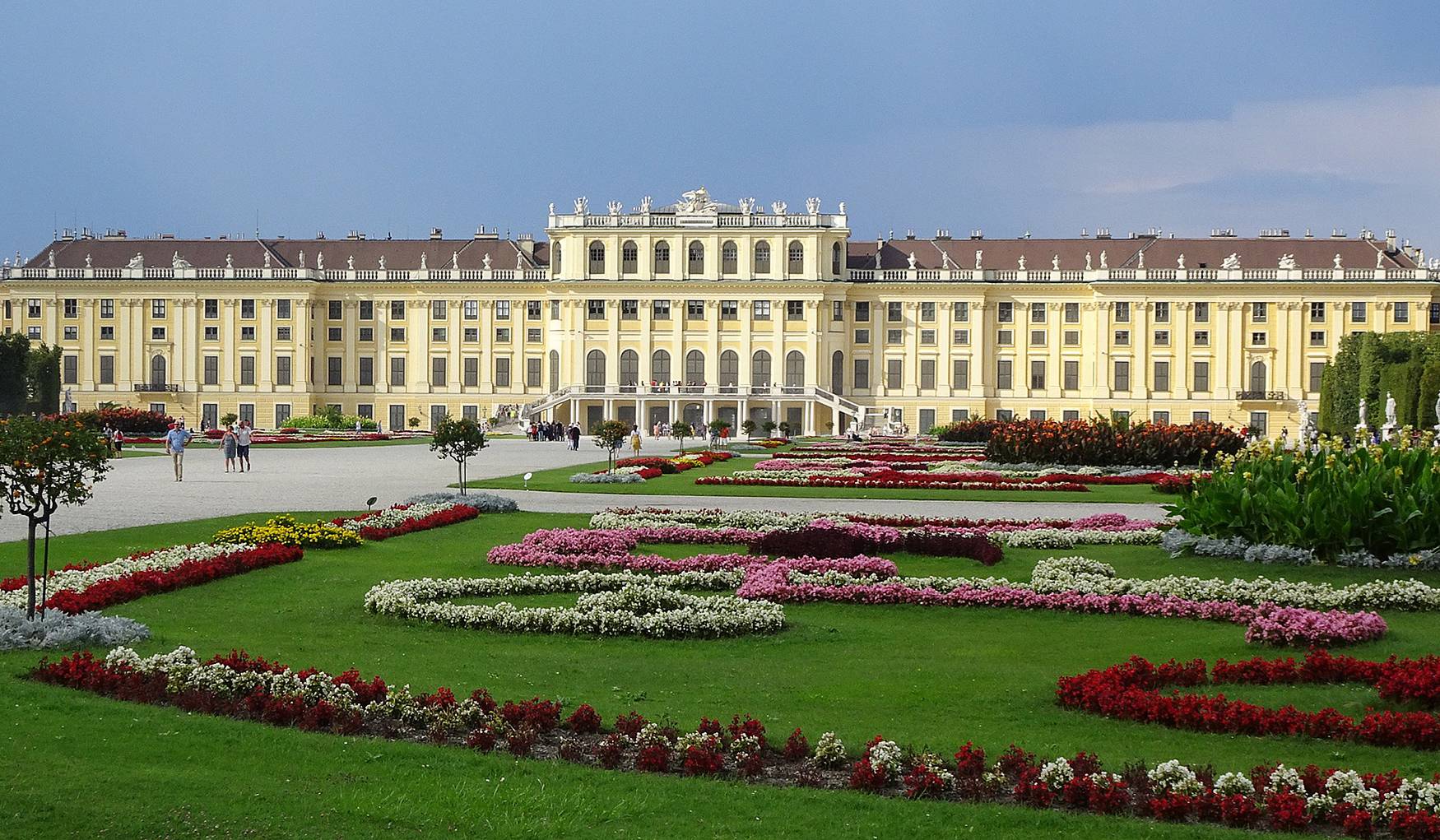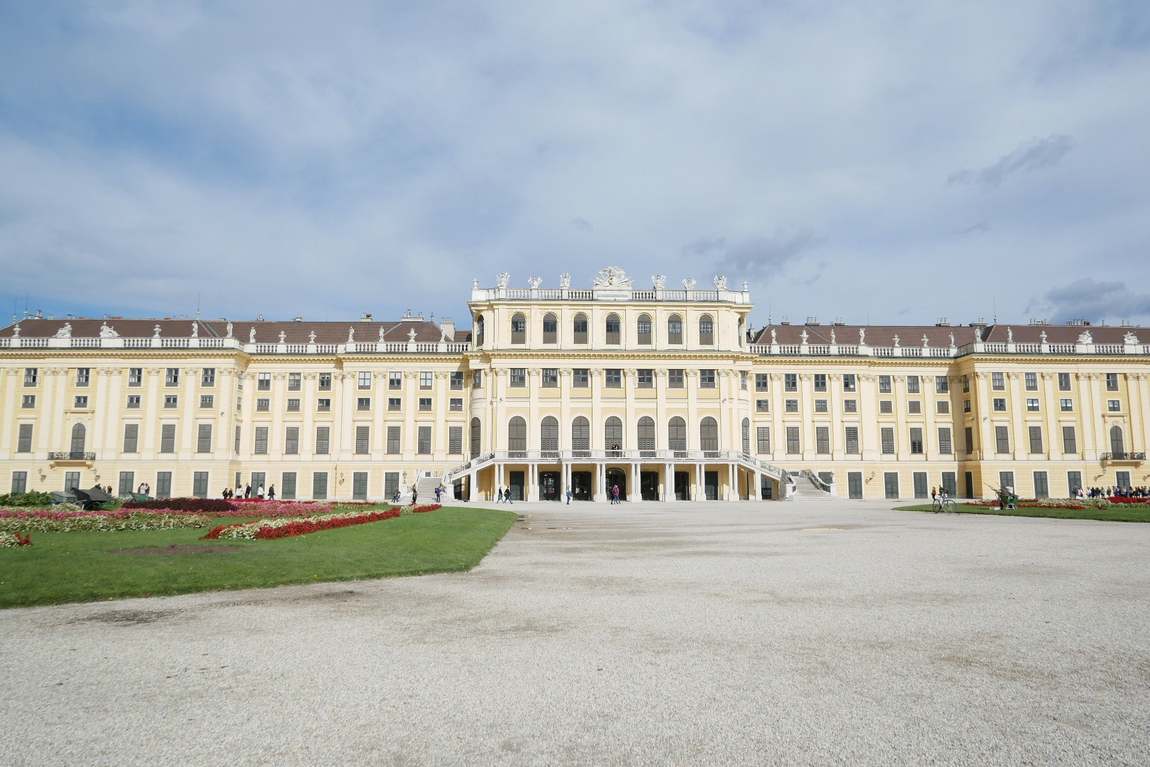Of course, children should be introduced to the most iconic sights of various cities around the world, and when it comes to Vienna, Schönbrunn Palace should be at the top of your 'what to see' list. Schönbrunn Palace is a famous cultural monument in Austria and was once the summer residence of the imperial family.
Today it is a UNESCO World Heritage Site and, together with the park and even the zoo on the grounds, receives thousands of admiring visitors. The complex is very large and beautiful, with many attractions of interest to both adults and children.
Some history
The history of Schönbrunn Palace and Gardens dates back to the 14th century, when the grounds were the property of a monastery and the area itself was called Kattenburg. Later, in 1569, the Habsburgs took possession of the land and used it for hunting.
Legend has it that while hunting, Emperor Matthias discovered the beautiful springs (Schöne Brunnen), which later gave the whole complex its name. Historians say that the spring itself was used to supply the imperial palace with clean water for a long time.
Unfortunately, in 1863 the grounds and the summer residence were completely destroyed by the Turks who invaded Vienna. Emperor Leopold, who in 1696 ordered the construction of a new palace and park complex based on the model of the Palace of Versailles, gave the residence a new lease of life. The work was supervised by the architect Johann Bernhard Fischer von Erlach.
In 1728 Charles VI took possession of the palace, which later passed into the hands of his daughter Maria Theresa, during whose reign Schönbrunn Palace in Vienna became the centre of courtly life. The palace opened a theatre in 1747 and Napoleon stayed there in 1806 and 1809. During the reign of Franz Joseph, who stayed here until 1916, Schönbrunn once again became the main residence of the emperor.
The 20th century and the bombing of the Second World War brought devastation to the palace, and it was not until 1992 that active restoration and reconstruction work began on the grounds.
Vienna's Schönbrunn Palace: Exhibition
Today the palace has 1,441 rooms, but only 45 rooms and halls are open to tourists.
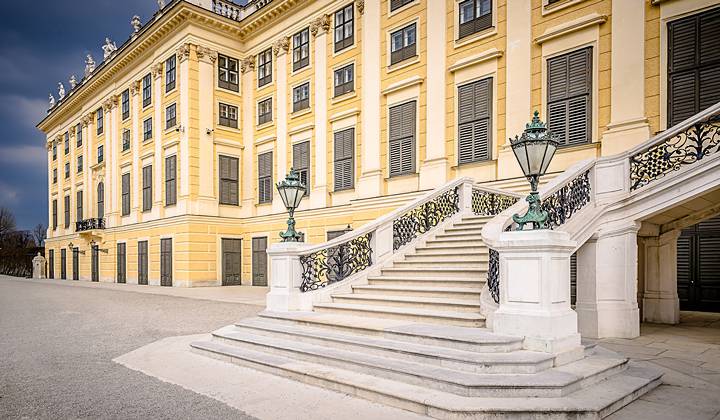
Among the most important and interesting are the following:
The Hall of Mirrors, decorated in the Rococo style. This is probably the most ornate and beautiful room in the palace, filled with vivid historical facts. Here ministers were sworn in, a young Mozart played for the Empress and Princess Charlotte of Lothargine and later Empress Maria Josephine held state receptions.
The room is richly decorated with precious 19th-century Chinese vases, large mirrors that make the room appear larger, and bronze clocks. The harmonious combination of gold and burgundy gives this room a particularly chic feel.
The Great Rosa Room is named after the artist Josef Rosa, who had the honour of decorating the room. Here you'll find a portrait of Maria Theresa, blue and white floor vases from Asia and landscapes from Switzerland and northern Italy.
The Great Gallery (often called the Ballroom) is impressive in its size. Once 43 metres long and 10 metres high, it was used for royal audiences, receptions and balls. The room was partially destroyed during the Second World War, but was rebuilt between 1947 and 1949.
The Small Gallery has a picturesque view of the castle park. It was used for smaller dinners, concerts and other events. The room is particularly decorated with golden stucco and a ceiling with beautiful frescoes.
The Roessel Room was originally used as a games room (Roessel = "chess horse"). From the 19th century it was used as a dining room.
The Ceremonial Hall (originally called the Batagliensaal). This is an elaborately decorated hall with paintings on the walls depicting ceremonies from different periods and many historical battles.
The Millions Room, decorated in an oriental style, is the most expensive room in terms of decoration. The room is decorated with rosewood panels and Indo-Persian miniatures.
Napoleon's Room. The emperor stayed in this room twice, and later his son, who was given the title of duke and died of tuberculosis at a very young age, also stayed here. An interesting exhibit in the room is the cage of the lark, which Napoleon's son loved to play with.
Guards Room. This room, decorated in shades of white and gold, was used for the distribution of instructions and orders to the guards.
Antechamber of Franz Joseph, where the monarch rested or held audiences.
Maria Theresa's bedroom with the most interesting exhibit, an authentic 18th century royal bed.
The Breakfast Room. During the reign of Empress Maria of Bavaria, breakfast was served to the whole family in this room. Of particular interest are the crockery, cutlery and tea set on the table.
The Rococo Yellow Room. The name of the room indicates the dominant colour of the decoration. The chairs are upholstered in golden silk, the walls are decorated with gilded mouldings and the delicate picture frames are also yellow.
The Bedroom of Franz Joseph, which, despite its owner's status, is rather modestly and simply furnished.
The office of Emperor Franz Joseph, like his bedroom, is characterised by simplicity of design. Every day at 5am, the Emperor began his working day in this room. The desk where the Emperor used to deal with important matters of state can be seen in the room, as can the stationery. Portraits of him and his wife Elisabeth of Bavaria hang on the walls.
The Bedroom of Emperor Franz Joseph I and Empress Elisabeth. This room was only used by the couple in the early years of their marriage. The walls of the room are upholstered in blue and gold silk, and the furniture, bed linen, clocks and candlesticks are interesting.
Children’s Museum
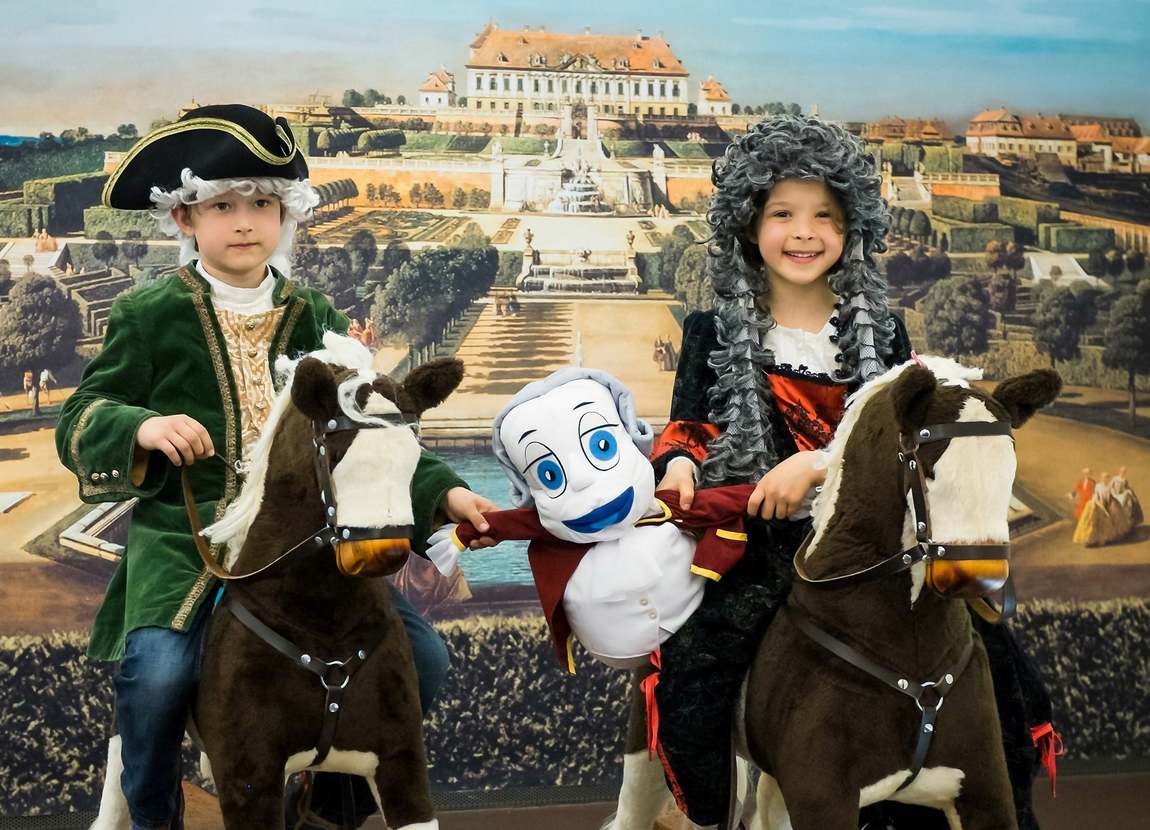
After running around and releasing their energy for peaceful purposes, children of all ages need a break. It's a good time to visit the children's museum complex. If you want to teach your children about Austrian history, Schönbrunn Palace is the easiest place to do it. The symbol of the children's museum is the amusing and friendly ghost Poldi (what's an old castle without ghosts?).
In the museum's halls, your children will be able to relax and discover beauty (as they say, mix business with pleasure). Let them comb one of the wigs, try on the cloak of an autocrat or a princess and sit on the imperial throne.
In the rooms of the Children's Museum you can not only see exhibits describing how the royal children lived, slept, played, studied and ate, but you can also play with toys and take part in setting the table in the dining room. They can also take part in an impromptu mini costume play and learn lots of interesting facts about Maria Theresa, the Empress who lived at Schönbrunn Palace with her husband and sixteen children many centuries ago.
Please note: The Children's Museum is located in the right wing of the palace. Minor children may only visit the museum if accompanied by an adult.
Don't forget to introduce your children to a dance that was once an important part of the social life of the imperial family — the quadrille. Today, in Empress Elisabeth's former gymnasium, which has been converted into a dance studio, masters of the quadrille give lessons to their young pupils. The surroundings, the music, the clothes and the manners of the teachers all reflect the festive spirit of the time.
Tourist train in Schönbrunn
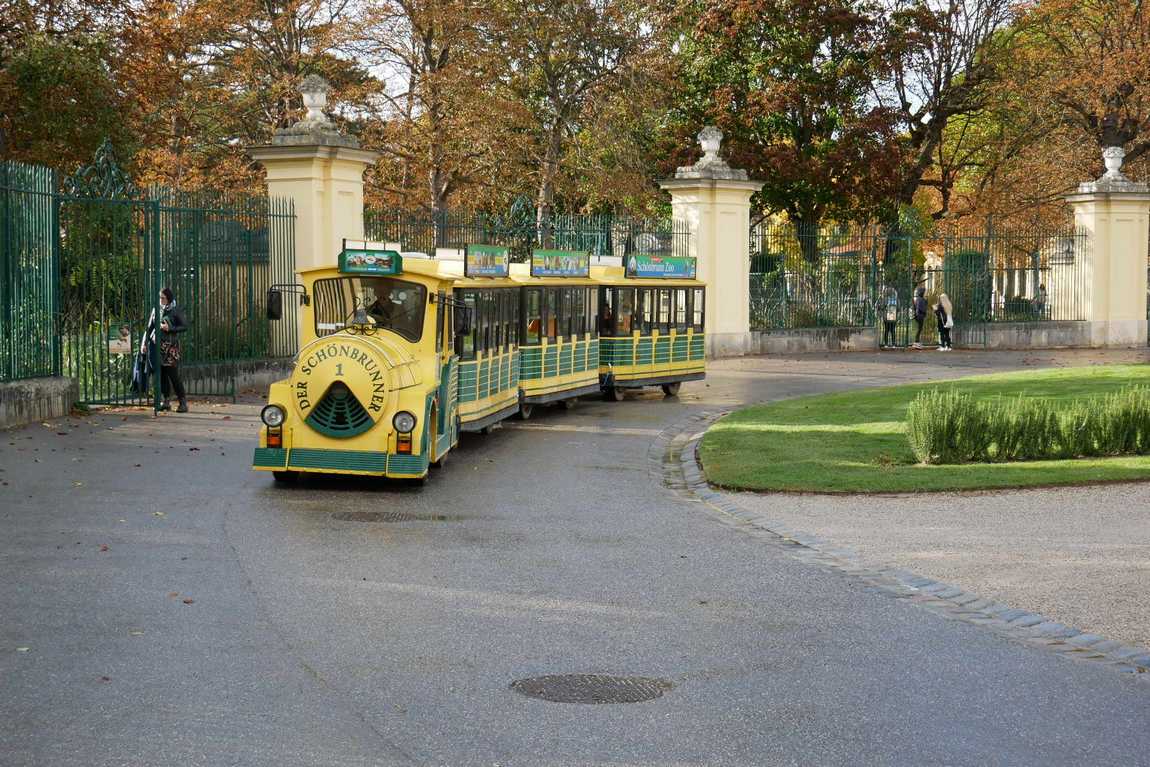
Even a full day is not enough to see all the sights of Schönbrunn Palace. But if you're short on time, or if you're visiting the park with young children, you can take a sightseeing train to see the highlights of Schönbrunn.
It's a quick and easy way to get an overview of this famous Viennese attraction. The train stops at the following locations:
- Schönbrunn Palace;
- Carriage Museum;
- Hitzinger Gate;
- Vienna Zoo;
- Tyrolean Garden;
- Gloriette Arch;
- Hohenbergstrasse;
- The fountains of Schönbrunn Palace, including the Obelisk/Schönbrunn Pool;
- Meidling Gate.
Two sightseeing trains run daily from 10:00 to 18:00. They stop at the Gloriette Arch and Schönbrunn Palace for one and a half hours. Please note that there are no guided tours on the train from 1 November to mid-March.
What else to see at Schönbrunn Palace
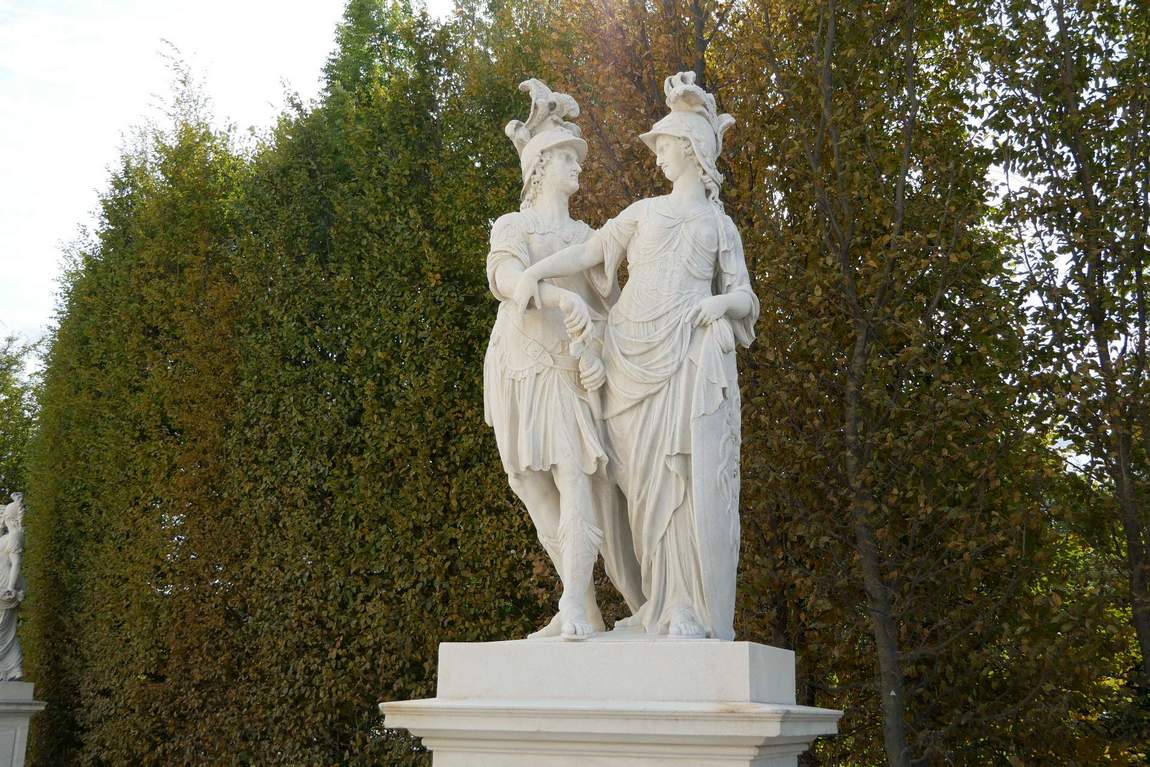
Don't limit your visit to the rooms and interiors of the palace, as there are many other interesting sights in the vast park. Here's a list of the most important ones, and before you visit them, we recommend you take a look at a map of the palace complex to see where they are located.
The Carriage Museum
The Carriage Museum at Schönbrunn opened its doors to the public in 1922. Its collection includes around 60 examples of imperial carriages, riding gear and clothing, various horse-related accessories and footmen's outfits. You can also see winter carriages and the children's carriages in which little princes and princesses used to travel.
Gloriette Arch
.jpg)
The Glorietta Colonnade, built in 1775 to celebrate the victory of the Austrian forces over the Prussian King Frederick III, is a harmonious addition to the ensemble of Schönbrunn Palace Park. Situated on the top of a hill, it offers a breathtaking view of the palace and its surroundings.
The Gloriette of Schönbrunn consists of a triumphal arch and two wings with columns on either side. In the past it was a dining hall with a beautiful view of the park and the palace, but today you can enjoy a coffee or a sweet pastry in the cosy café.
In the warmer months you can climb to the roof of the pavilion, which has a terrace and viewing platform. The views over the city and Schönbrunn Palace are breathtaking. Note that access to the terrace is closed in winter.
The Glorietta (terrace) is open to the public:
- 15 March to 30 June: 9:00 to 18:00.
- 1 July to 31 August: 9:00 am to 7:00 pm.
- 1 September to 30 September: 9:00 am - 6:00 pm
- 1 October to 24 October: 9:00 am to 5:00 pm
- 25 October to 6 November: 9:00 - 16:00
The Japanese garden
Not far from the Palmery in Schönbrunn Park is the Japanese Garden, laid out by gardeners in 1913. Here you will find typical elements of the Japanese landscape: artistically placed stones, moss, a tea pavilion, a waterfall and small ponds, ornamental cherry trees, Japanese maples and other beautiful plants that emphasise the sophistication of the place.
Neglected for almost a century, the garden was restored by Japanese experts in the late 1990s and is now a delight to behold in all its picturesque splendour and amazing tranquillity.
Neptune's fountain
This is the main fountain in the palace and park complex. It is located behind the palace, at the foot of the hill, and it is impossible not to notice it. It was designed by Johann Ferdinand Hetzendorf and built by the master craftsman Wilhelm Beyer.
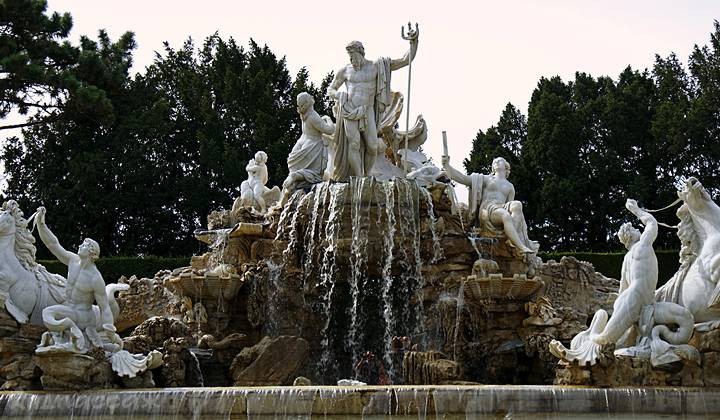
The original plan was to build an ensemble of four fountains, but after careful analysis at the start of construction it became clear that the flow of water was simply not enough for such a powerful structure, so only one fountain was left. But what a fountain!
The fountain has three levels. The two lower levels are bowls decorated with beautiful bas-reliefs and ornaments. The upper level, the central one, is a stone grotto on which Neptune, the god of the sea, stands with a trident in his hand, surrounded by newts and mythical creatures. To his left is a nymph and to his right the kneeling goddess Thetis.
The fountain is open daily from 10:00 to 16:00 during the warm season. The operation of the fountain can also be affected by weather conditions.
The Palm House (Palmenhaus)
It is a large orangery built in 1882 in the grounds of Schönbrunn Park. The unusual building made of 5,000 glass blocks immediately attracts the attention of visitors.
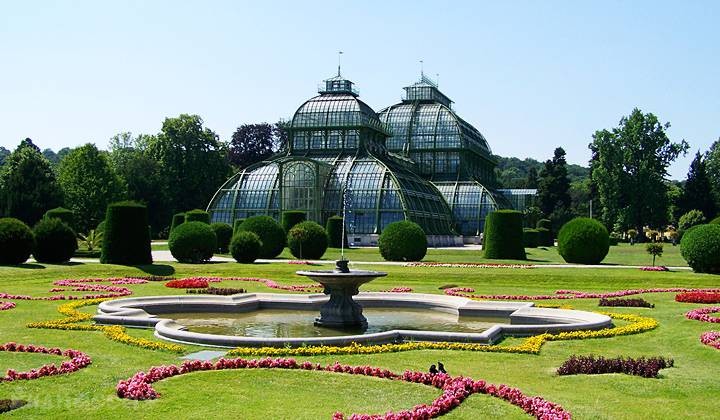
The Palm House consists of a central pavilion and side pavilions, each with a different climate: the central pavilion recreates a relatively dry Mediterranean environment, the northern pavilion a 'cold' environment and the southern pavilion a 'tropical' environment. As a result, the greenhouses contain plants from all over the world.
The Palm House is open daily from 1 May to 30 September: 9:30-18:00; from 1 October to 30 April: 9:30-17:00.
Schönbrunn Zoo
Situated in the grounds of Schönbrunn Palace, the zoo proudly holds the status of the oldest zoo in the world and often tops the rankings of the best zoos in Europe. Its construction was organised by Maria Theresa's husband and wife in 1752. Today, the baroque zoo is home to around 700 species of animals.
In the Polararium you can introduce your children to seals, penguins and polar bears. The Jungle House is home to the most incredible inhabitants of the rainforest, and in the Tyrolean Gardens you can listen to rare birdsong and see animals that are now threatened with extinction.
The House of the Apes, the Elephant Park and the large aquariums will amaze and delight you with their inhabitants. The most popular attraction is the feeding of the animals in front of the public.
The Labyrinth
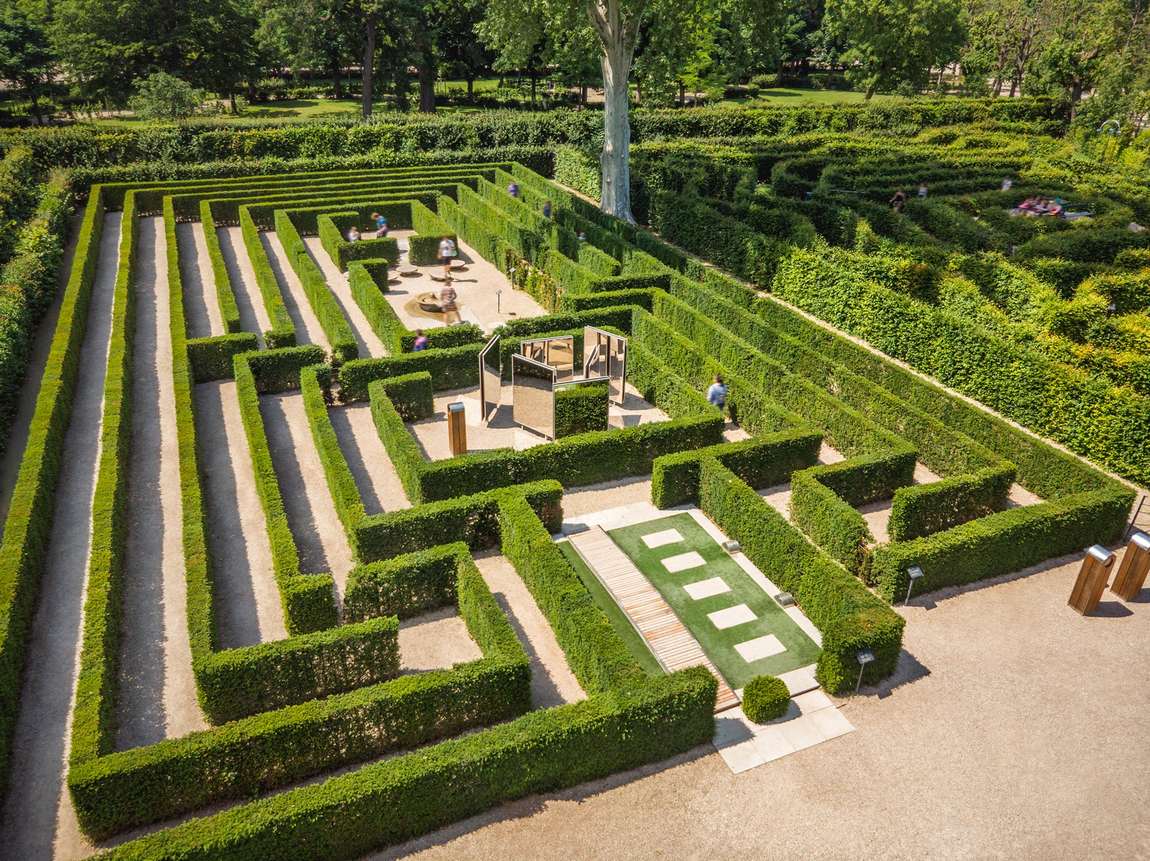
Another interesting adventure awaits young visitors to Schönbrunn Palace in Vienna: a walk through the mazes (there are actually three in the park).
The first labyrinth at Schönbrunn was built in the 17th century and was used by members of the imperial family. By the end of the 19th century there was practically nothing left of it and in 1998 it was rebuilt to look as close as possible to the original.
Today it covers an area of 1,715 square metres, half the size of its predecessor. The walls of the maze are slightly higher than human height and there is a viewing platform in the middle from which you can watch the other participants in the 'quest'.
The second maze is specially designed for children. Play areas are an integral part of it. The walls of this labyrinth are only 140 cm high.
Children under the age of 14 must be accompanied by an adult.
Next door is the fascinating playground, where children can get their first glimpse of a giant Archimedean propeller and experience the giant iron bird designed by Günter Beltzig. The engineer is a renowned specialist in original playground structures.
The third maze is the same height as the first. It is more interactive: inside, visitors are invited to play several games, including mathematical problems and dexterity games.
Strudel show
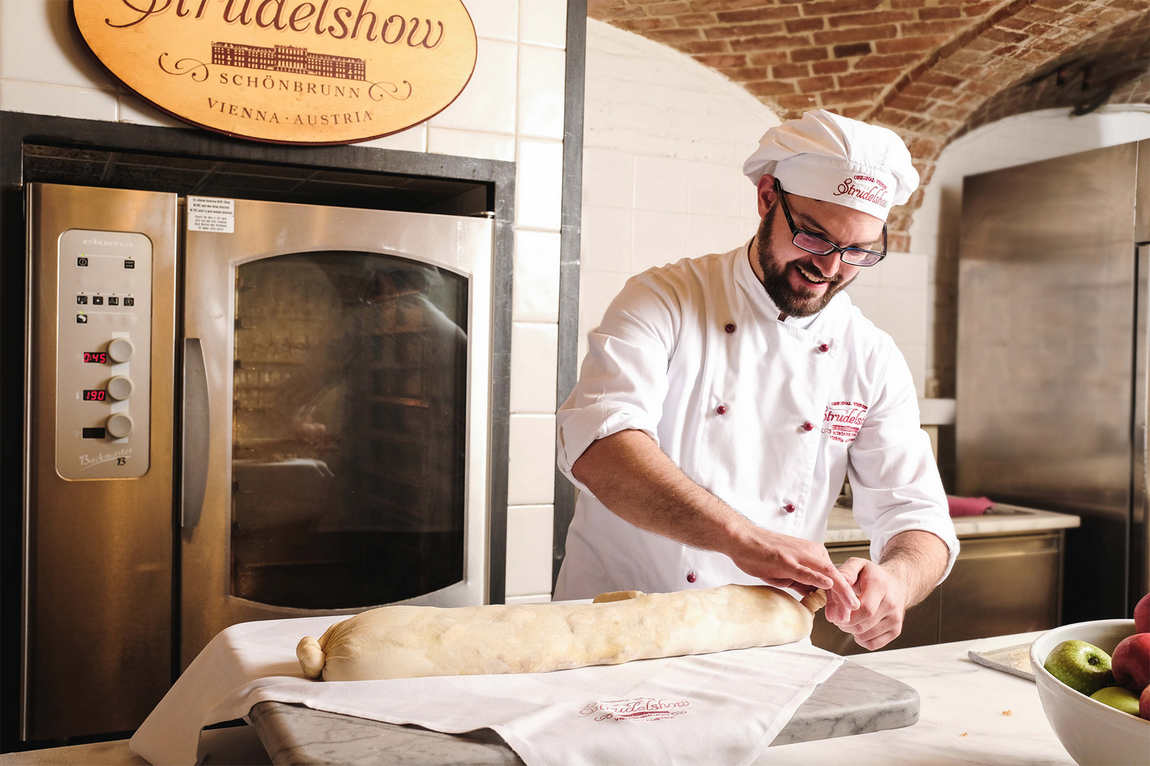
An interactive master class is held on the territory of the cafe "Residenz". The show is held every hour, the palace bakers will share a unique recipe for one of the most popular desserts in Vienna — apple strudel.
Dovecote
An interesting building on the grounds of the palace, which is still in use today. Three species of pigeons live in the imperial dovecote, and the room itself is equipped with houses and special drinking troughs.
Concert in Schönbrunn Palace Park
Every year during the warm season (May-June) the Vienna Philharmonic Orchestra gives an open-air concert in the park, which is completely free of charge. The stage is set up by the Neptune Fountain and the performance begins after 8 p.m. The summer evening concert in the park of Schönbrunn Palace has become a tradition with over 70,000 people attending.
If you visit Schoenbrunn Palace and Park in Vienna, you will want to return here to experience the historic atmosphere that hangs in the air.
Ticket types for Schoenbrunn Palace & Park
When planning your trip, choose the right ticket for your family. There are many options, from cheap ones that give you a general idea to expensive ones that allow you to visit all the possible sights and museums within the palace complex. So which Schönbrunn ticket should you choose?
Imperial Tour
22 rooms, audio guide
The Imperial Tour is ideal if you are interested in Franz Joseph and Elisabeth but have limited time. Become a guest of Emperor Franz Joseph and his wife Elisabeth and explore the rococo state rooms of the palace!
On the Imperial Tour of the twenty-two rooms, you'll start with the apartments of Franz Joseph, whose rooms were decorated and furnished with astonishing care, and then move on to the apartments of his famous wife, Sisi. You can then admire the sumptuous splendour of the Grand Gallery, the exotic charm of the Chinese Rooms and the magnificent Ceremonial Hall.
Grand Tour
40 rooms, audio guide
A visit to the exquisite rooms from the time of Maria Theresa completes the Imperial Tour.
Most of the rooms, which are undoubtedly luxurious, are also remarkable for their East Asian decoration and furnishings, in particular the Blue Chinese Salon and the Vieux Lac Room, which follow the Hall of Ceremonies. After the death of Emperor Francis Stephen, the Vieux Lac Room was converted into a memorial room. The Porcelain Room is followed by the Fekete Room, named after Maria Theresa, which soon after the end of the monarchy became known as the Hall of Millions because of its precious rosewood panels. The Tapestry Room is hung with exquisite Brussels tapestries. The tour ends in the Rich Room, which houses the only surviving state bed from the Viennese Court.
The Grand Tour is an experience not to be missed!
Sisi Ticket
3 imperial sights for 1 ticket: Schönbrunn Palace + Sisi Museum plus the Imperial Apartments and the Imperial Silver Collection at the Vienna Hofburg + Vienna Furniture Museum - you save 25%!
Classic Ticket
Visit 5 attractions with 1 ticket: a special package with many advantages: Schönbrunn Palace, Secret Garden, Orangery Garden, Labyrinth and Gloriette.
Culture and history, fun, light exercise and views - the best value for a morning or afternoon at Schönbrunn!
The Schönbrunn Classic Pass is a special package that includes:
- Grand Tour of Schönbrunn Palace with audio guide
- The Secret Garden: A stroll under the shady pergolas
- Maze and Labyrinth: Fun, games and relaxation for children and adults
- Orangery Garden: Relax in a historic garden
- The Glorietta with its viewing terrace: fantastic panoramic views over Vienna
By purchasing the Schönbrunn Classic Pass, you can enjoy a number of benefits
- Adults save up to 30% on the price of individual tickets!
- The ticket entitles you to a single visit to all the attractions included.
- Classic Passes are valid on the day of issue.
- The tour lasts approximately 3-4 hours.
Classic Ticket Plus
The Schönbrunn Classic Ticket is a special package that includes:
- Grand Tour of Schönbrunn Palace with audio guide
- Schönbrunn Zoo: Admission to the oldest zoo in the world
- Secret Garden: stroll under the shady pergolas
- Labyrinth and Maze: fun, games and relaxation for children and adults
- Orangery Garden: relax in a historic garden
- Glorietta with viewing terrace: fantastic panoramic views over Vienna
- Desert House
- Palm House
Family ticket
With the Family Pass you can immerse yourself in the world of courtly life of centuries past at Schönbrunn Palace, the Schönbrunn Children's Museum and Schloss Hof in Marchfeld.
Perfect for families!
- Schönbrunn Palace - Imperial Tour with Audio Guide
- 22 rooms / 35 minutes
A tour of contrasts including the extravagant splendour of the Great Gallery, the oriental charm of the Chinese Rooms and the unusually modest furnishings of Emperor Franz Joseph's private apartments.


